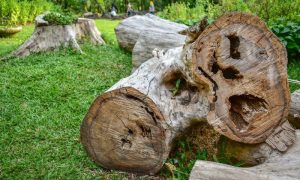Dead Tree in Your Yard
A dead tree in your yard can be an unwelcome sight, raising questions about what to do next. While the presence of a deceased tree might seem like a concern, it also presents opportunities for creative solutions and responsible management. In this guide, we will explore various options and considerations for dealing with a dead tree in your yard, from removal and repurposing to enhancing your landscape’s aesthetics and ecological value. Whether you’re aiming to ensure safety, boost your yard’s visual appeal, or contribute to wildlife habitat, there’s a path forward that aligns with your goals and the well-being of your outdoor space.
Removing a tree
Professional Removal
Hiring a professional tree removal service is the most secure and popular choice. They can safely chop down and remove the dead tree since they have the knowledge, tools, and experience to do so.

Homemade Removal
You can try to remove the tree manually if it’s not too big and you have the right tools and abilities. It is not advised to do this with large trees or those that are close to structures because it can be dangerous.
Utilize the Wood
The wood of the dead tree can be used in a variety of ways, including:
can be use in fireplaces or wood-burning stoves, cut and split firewood.
Woodworking
You can use the wood to make furniture or other items for your home.
Mulch
For your garden or landscaping, chop the branches and use the wood chips as mulch.
Environment for Wildlife
Consider keeping the tree in place if it is that area where it doesn’t pose a safety risk. Dead trees, also referred to as “snags,” can be a useful habitat for birds, insects, and other wildlife.
Features of the arts
Some people decide to carve or use dead trees into their landscape design in order to transform them into aesthetic pieces.
Speak with an arborist
Consult a qualified arborist if you’re unclear about the tree’s condition or the best course of action. They can evaluate the tree’s condition and offer advice on whether it should be cut down or whether any of its pieces can be salvaged.
Replace an Existing Tree
Consider planting a new tree if you decide to remove a dead one. This keeps your yard’s aesthetic appeal and ecological balance maintained.
Properly dispose of the tree
Make plans for proper disposal through your local waste management organization if you decide to remove the tree. Verify any applicable local laws or licenses that may be needed.
Related Posts:
Donate or reuse wood
Consider giving the wood to a nearby woodworking shop, a community project, or an organization that can utilize it if the tree is good for woodworking
Recycle or give wood
If the tree is suitable for woodworking and you don’t need the wood, think about giving it to a nearby woodworking shop, a neighborhood project, or a group that can use it.
Decorating or painting a dead tree
Wrapping the dead tree’s limbs in fairy lights will give them a wonderful and enchanted appearance, especially in the evening
To draw birds and provide them with a habitat, hang birdhouses or bird feeders from the branches. As a result, the dead tree may become a popular spot for birdwatching.
If you have creative talent, you might paint the dead tree with vivid hues or elaborate patterns to create a striking sculpture for your garden
To create visual interest and movement, hang vibrant wind chimes, mobiles, or ornaments from the branches.
If the tree has a sturdy structure, consider planting climbing vines that will grow over the branches, adding greenery and texture.
Change the decorations with the seasons. For example, you can add ornaments and lights for the holidays or incorporate seasonal flowers and wreaths.
Turn the dead tree into a memorial or tribute by adding photographs, mementos, or artwork that holds sentimental
Should dead trees be cut down?
- Dead trees are unsuitable and are more likely to fall or drop branches which can cause damage to property,people and pets
- Dead trees can cause disease and pests,fungi and can damage nearby healthy trees
- Dead trees are unsightly and can detract from the overall beauty of your landscape
- Removing dead trees can improve appearence of your yard or lawn
- Dead trees can fall and cause damage to roads,property,vehicle and other valuable assets
- Dead trees are more flammable then healthy trees, making them a potential fire hazards especially in areas prone to wildlife
- Leaving dead tree standing also known as snags can provide habitat for wildlife inclusind birds and insects
What are the signs that my tree is dead?
Signs of a dead tree include brittle and dry branches, lack of leaves during the growing season, fungal growth on the trunk, and bark falling off.
Is it necessary to remove a dead tree from my yard?
Yes, it is typically advisable to remove a dead tree, especially if it poses safety hazards, such as falling branches, or if it’s near structures or high-traffic areas.
Can I leave a dead tree in my yard for wildlife habitat?
Yes, dead trees, also known as “snags,” can provide valuable habitat for wildlife. Ensure it doesn’t pose safety risks before leaving it in place.
Can I use the wood from a dead tree for firewood or other purposes?
Yes, you can repurpose the wood for firewood, woodworking projects, or as mulch for your garden, provided it’s not diseased or infested.
Conclusion
In conclusion, dealing with a dead tree in your yard is essential for safety and aesthetics. Removing it, when necessary, can prevent accidents and property damage, while repurposing the wood and creating artistic features can add beauty and functionality to your landscape. Always prioritize safety and consult experts when unsure.




